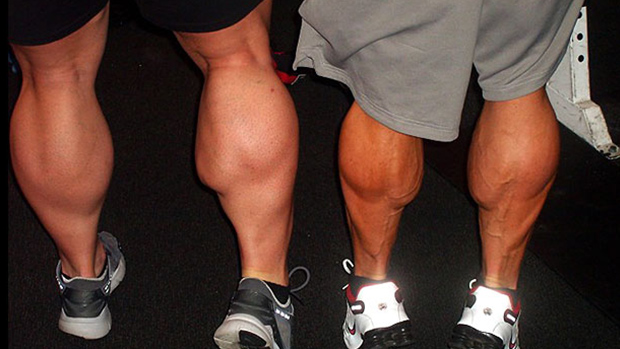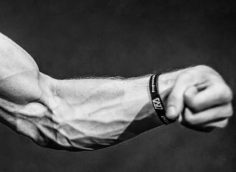Here's what you need to know...
- You should be able to perform 20 single-leg calf raises through a full range of motion while standing flat on the ground.
- This is the normative strength value for the average person off the street, but most lifters can't even come close.
- To determine your initial strength level, first perform one set of single-leg calf raises for each leg for as many reps as possible.
- Perform 3 sets of as many reps as possible with each leg, holding for 2 seconds at the top, spread throughout the day. Do this every day for two weeks.
- The final goal is to achieve 10 perfect, unassisted single-leg calf raises with a 2-second peak contraction hold at the top of each rep.
The vast majority of lifters out there don't need machines, weights, or any contraption to build their calves.
If you're a male that can perform eight reps of a single-leg calf raise with a 50-pound dumbbell at your side, I can almost guarantee that you're using accessory knee or trunk movement to accomplish the task and/or your peak height of plantar flexion is lower than it should be.
How do I make these claims? Experience. I've stumbled upon a training approach that's produced the most impressive calf development that I've seen. Furthermore, the plan requires no equipment and you can do the sets literally anywhere.
Part of my Doctor of Physical Therapy (DPT) training covered normative strength values for every muscle group. Weakness is a huge component of dysfunction so it makes sense that any good DPT should know how to determine if a muscle is too weak.

When it comes to the calves – mainly the gastrocnemius and soleus muscles – you should be able to perform 20 single-leg calf raises through a full range of motion while standing on the ground.
Importantly, the test stops if your knee bends even the slightest or if you can't elevate your body as high as the previous rep. Balance is maintained with just the fingertips of one hand against a wall or chair.
Seems simple enough, right? I mean, those calf raises are just performed from the floor. You don't have to perform them off the edge of a step that requires ankle to dorsiflex past 90 degrees, which would greatly increase the demand on the plantar flexors.
I tested my calf strength as it relates to the physical therapy world and this is how I measured up:
- Right single-leg calf raise: 12 reps
- Left single-leg calf raise: 14 reps
I wasn't surprised that I could do more reps with my left calf since that's the leg I jumped off of for many years while playing basketball. My left calf has always been slightly larger than my right as well.
However, I was surprised that I couldn't perform 20 standing calf raises with either leg!
Keep in mind, 20 single-leg calf raises is the normative strength value for the average person off the street. It doesn't take into account a guy that wants to build his calves to match the circumference of his upper arms – the gold standard ratio that looks the best for any hard-training guy.
Here's something we all know: The guy with the biggest muscles isn't always the strongest guy in the gym.
There certainly are genetic factors at work that allow some lucky people to sport incredibly large calves without any direct training to those muscles. Many pro bodybuilders fall into that category and that's why their calf training routines won't make your underdeveloped calves grow.
Genetics aside, there is a direct, scientific relationship between size and strength. There are six factors that increase muscle force, and physiological cross-sectional area (PCSA) is at the top of the list. So if you increase the PCSA you will increase the muscle's ability to produce more force.
This is how scientists determine your PCSA:
- PCSA = muscle mass x cosine (pennation angle)/muscle density x fiber length
Memorizing the equation isn't important, but understanding the concept definitely is: PCSA is directly proportional to maximal tetanic tension (force) of muscle.
So if we reverse that statement and achieve the standard measure of calf strength in the physical therapy world, will it increase the PCSA of your calves? Yes, it definitely will!
Since I failed to achieve 20 single-leg calf raises through a full range of motion on either leg, I wondered how my clients would do. I was shocked to discover that the people I train who want bigger calves couldn't achieve 20 single-leg calf raises either.
Most of the athletes I tested could only perform 7-14 reps with either leg using the technique I'll describe later.
Now it's obvious that trying to achieve 20 straight reps is a test of endurance strength, but it's still a strength test. It's just that the physical therapy world feels that 20 straight reps is more important than a one-rep max test for overcoming dysfunction.
Since the calves often respond well to higher reps due to the muscle fiber make-up, I put a group of athletes on a high frequency training (HFT) plan to overcome their strength deficit. After six weeks every guy reported that he experienced more calf growth than ever before.
Here's the plan I gave them.
Step 1 – Determine your initial strength level.
"If you're not testing, you're guessing" is a powerfully accurate mantra. First get an honest measure of your strength levels.

How to do it: Perform one set of the single-leg calf raise with each leg without shoes.
First, you should use the least assistance possible to maintain your balance. Try to perform 3-4 single-leg calf raises without holding on to anything to recruit your ankle stabilizers.
Then rest 30 seconds and perform one set to failure using nothing but the tips of your fingers against a wall or resting on a countertop, chair, etc. to maintain your balance.
Technique tips: You must keep your working leg locked perfectly straight with every rep. No knee flexion or trunk swaying allowed whatsoever. Terminate the set once your ability to elevate decreases – even by a smidge – compared to the rep that came before it. Make a note of how many reps you achieve with each leg.
Step 2 – Perform 3 sets of as many reps as possible (AMRAP) with each leg, spread throughout the day. Do this every day for two weeks.
The muscle-building power of HFT comes from increasing the frequency that you stimulate a muscle. Therefore, the three sets should be spread throughout the day: one set in the morning, afternoon, and evening. No calf training in your normal workouts.
How to do it: Start with your strongest calf first because there will be neural carryover to your weaker side, thus making you stronger. Perform each calf raise slowly, drive through your big toe, and reach the highest elevation possible by squeezing your calf to peak tension for 2 seconds with each rep.
It's best to perform the calf raise without shoes, but it's not absolutely necessary. You can do the calf raise with shoes on if you're standing in line at the grocery store or putting gas in your car. Just get the damn sets done!
Terminate the set once your knee flexes or your ability to elevate decreases by one inch. Rest 30 seconds between each side.
Technique tips: It's common for people with poor calf development to experience a calf cramp when they try to squeeze the muscle to peak tension. Cramping often occurs when there's a glitch in the neural pathway and the culprit can be an overly compressed spinal nerve root.
The solution here is to maintain a long spine throughout the set. Imagine there's a wire attached to the top of your head and someone is pulling up on it. This opens the intervertebral space in your spinal column and allows freer nerve transmission from your vertebrae to your muscles.
Step 3 – After 2 weeks retest your standing single-leg calf raise.
Once you've completed two weeks of daily training, take one full day off from calf raises. The following day, 48 hours after your last set of calf raises, retest your standing single-leg calf raise from the floor.
Importantly, the test reps aren't performed the same as the work sets. The test reps are performed slowly, but there's no squeeze for 2 seconds at peak contraction. Just perform a normal set of as many reps as possible.
If you still fall short of the 20-rep mark, continue with the plan for two more weeks and retest again. Or maybe you achieved 20 reps on your right, but only 17 on your left, smaller side. You could continue with the plan for one more week for your left calf only and retest. There are many options here that make sense, so use your own best judgment.
Step 4 – Progress to a standing single-leg calf raise with no balance assistance.
Now, let's say you can perform 20 perfect single-leg calf raises with each leg. Your next mission is to perform all reps using absolutely no balance assistance – zero, zilch, none!
It'll be very frustrating at first because you'll be wobbling like a drunkard. However, the increased neural drive to your calf and ankle will recruit more muscles and motor units.
Just look at the calf development of any ballet dancer and you'll have real-world proof that unassisted calf raises from the floor will do wonders for your calf girth.
Your goal is to achieve 10 perfect, unassisted single-leg calf raises with a 2-second peak contraction hold at the top of each rep. That's how you reach a level of calf development beyond the physical therapy norms.
Full disclosure: This can takes months to accomplish. However, in pursuit of that goal I bet you'll add more calf mass than ever before.




